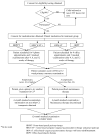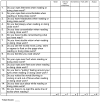The convergence insufficiency treatment trial: design, methods, and baseline data
- PMID: 18300086
- PMCID: PMC2782898
- DOI: 10.1080/09286580701772037
The convergence insufficiency treatment trial: design, methods, and baseline data
Abstract
Objective: This report describes the design and methodology of the Convergence Insufficiency Treatment Trial (CITT), the first large-scale, placebo-controlled, randomized clinical trial evaluating treatments for convergence insufficiency (CI) in children. We also report the clinical and demographic characteristics of patients.
Methods: We prospectively randomized children 9 to 17 years of age to one of four treatment groups: 1) home-based pencil push-ups, 2) home-based computer vergence/accommodative therapy and pencil push-ups, 3) office-based vergence/accommodative therapy with home reinforcement, 4) office-based placebo therapy. Outcome data on the Convergence Insufficiency Symptom Survey (CISS) score (primary outcome), near point of convergence (NPC), and positive fusional vergence were collected after 12 weeks of active treatment and again at 6 and 12 months posttreatment.
Results: The CITT enrolled 221 children with symptomatic CI with a mean age of 12.0 years (SD = +2.3). The clinical profile of the cohort at baseline was 9Delta exophoria at near (+/- 4.4) and 2Delta exophoria (+/-2.8) at distance, CISS score = 30 (+/-9.0), NPC = 14 cm (+/- 7.5), and near positive fusional vergence break = 13 Delta (+/- 4.6). There were no statistically significant nor clinically relevant differences between treatment groups with respect to baseline characteristics (p > 0.05).
Conclusion: Hallmark features of the study design include formal definitions of conditions and outcomes, standardized diagnostic and treatment protocols, a placebo treatment arm, masked outcome examinations, and the CISS score outcome measure. The baseline data reported herein define the clinical profile of those enrolled into the CITT.
Figures


References
-
- Scheiman M, Wick B. Clinical Management of Binocular Vision: Heterophoric, Accommodative and Eye Movement Disorders. Philadelphia: Lippincott, Williams and Wilkins; 2002.
-
- Scheiman M, Gallaway M, Coulter R, et al. Prevalence of vision and ocular disease conditions in a clinical pediatric population, in review. J Am Optom Assoc. 1996;67:193–202. - PubMed
-
- Rouse MW, Hyman L, Hussein M, Solan H CIRS group. Frequency of convergence insufficiency in optometry clinic settings. Optom Vis Sci. 1998;75:88–96. - PubMed
-
- Rouse MW, Borsting E, Hyman L, et al. Frequency of convergence insufficiency among fifth and sixth graders. Optom Vis Sci. 1999;76:643–49. - PubMed
-
- Daum KM. Convergence insufficiency. Am J Optom Physiol Opt. 1984;61:16–22. - PubMed
Publication types
MeSH terms
Grants and funding
LinkOut - more resources
Full Text Sources
Medical
Molecular Biology Databases
